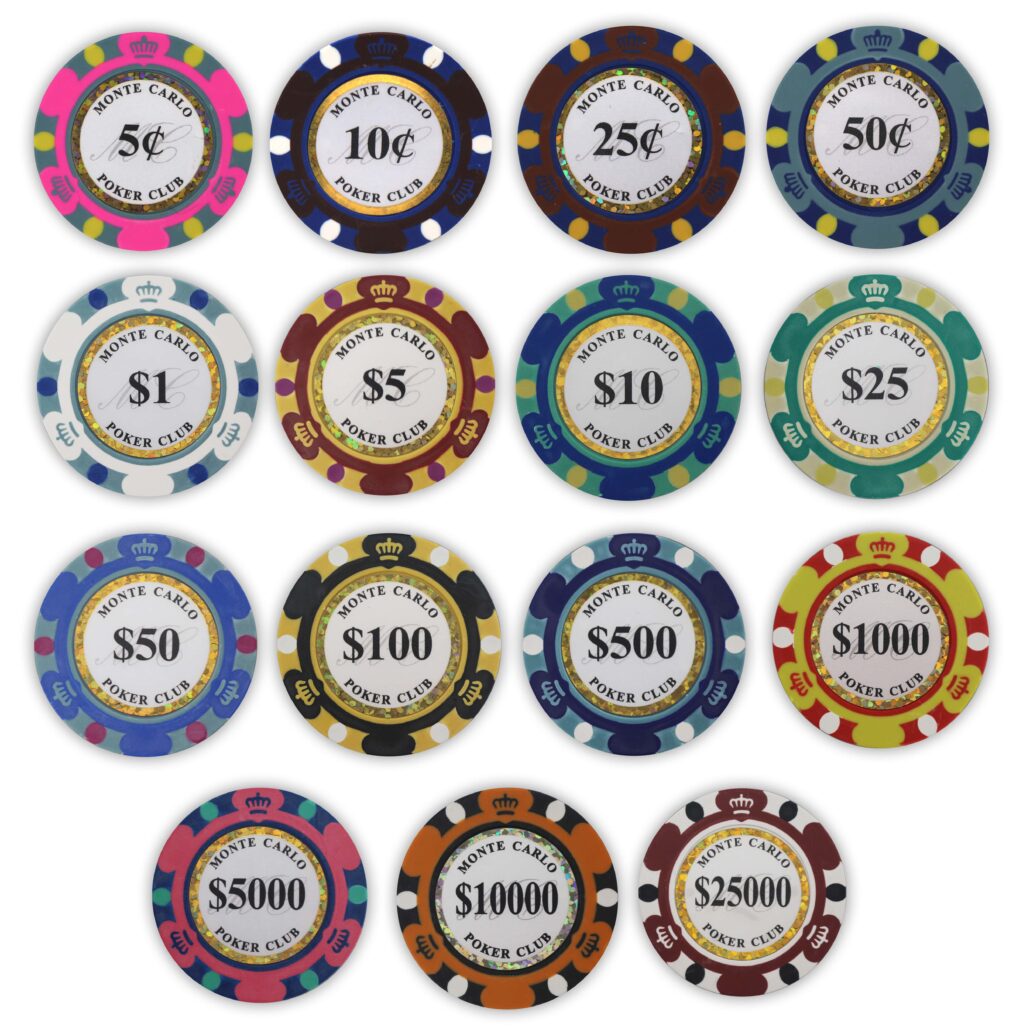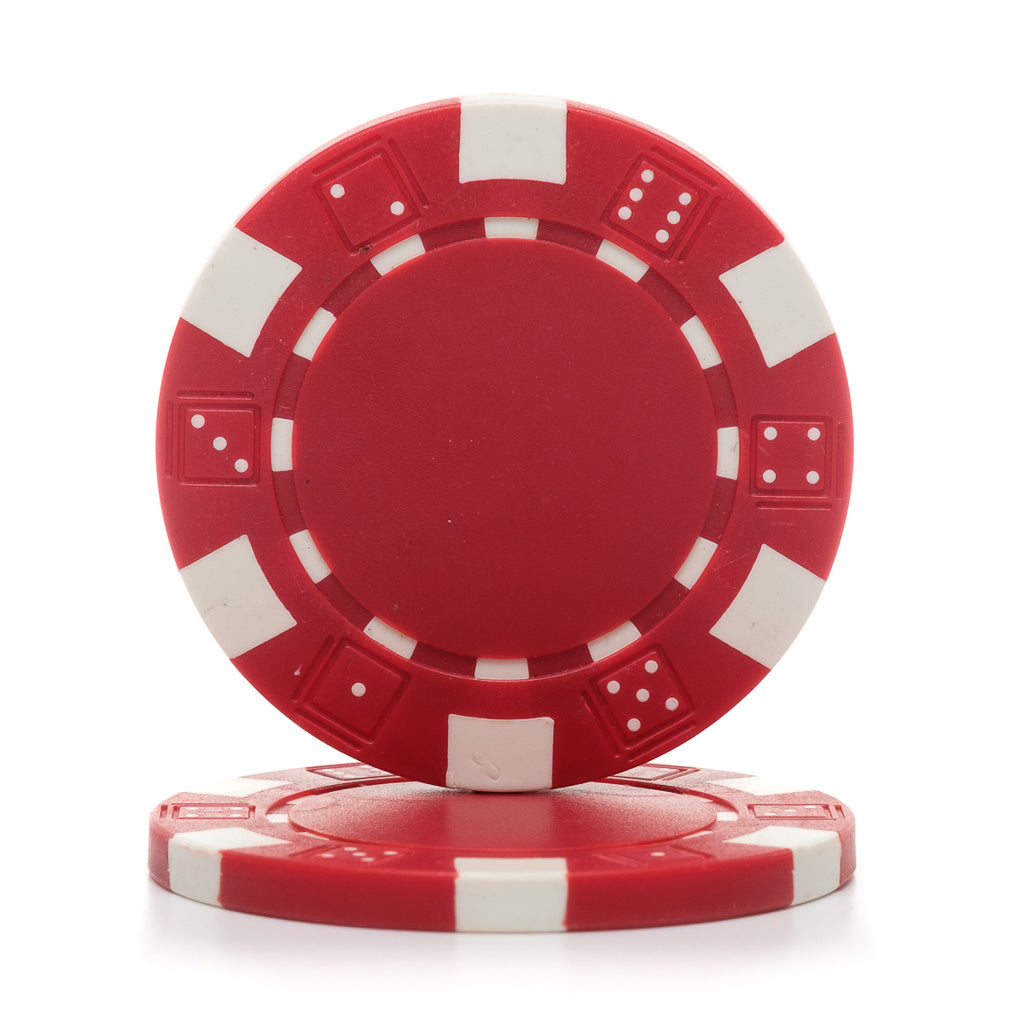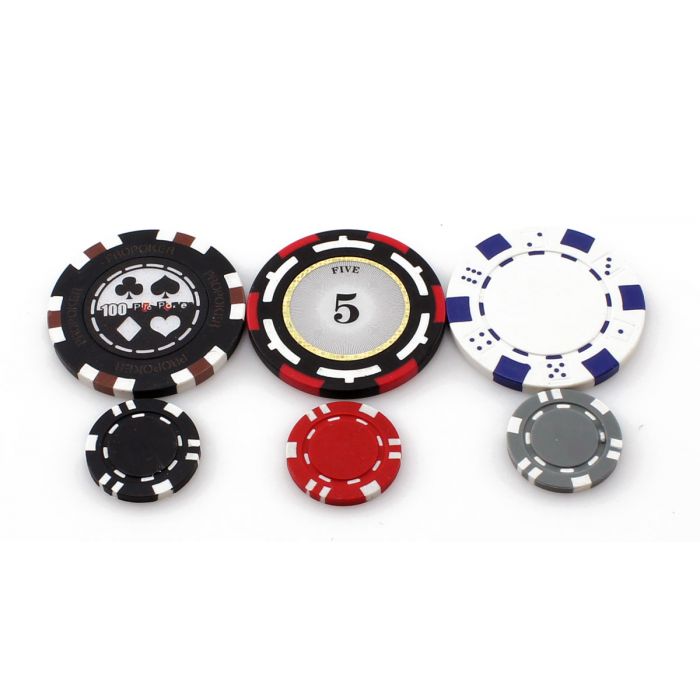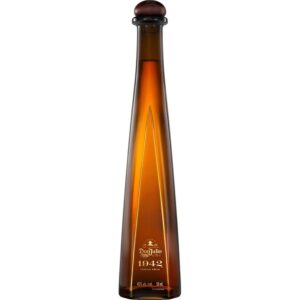Poker chips are small, round tokens used in gambling games to represent money. They come in various colors and denominations.
Poker chips enhance the gaming experience by providing a standardized betting system. Made from materials like clay, plastic, or ceramic, they come in various colors and designs. Casinos and home games use them to simplify transactions and keep the game orderly.
Each color typically represents a specific value, making it easy to manage bets and winnings. Using poker chips adds a tactile element to the game, making it more engaging. Players can easily stack, shuffle, and handle chips, adding a physical dimension to the excitement of poker. Whether in professional tournaments or casual home games, poker chips are essential for a smooth and enjoyable poker experience.
History Of Poker Chips
Poker chips have been a crucial part of the game of poker for many years. They represent real money and add an element of excitement to the game. The history of poker chips is rich and fascinating, revealing how these small discs have evolved over time.
Early Beginnings
The earliest forms of poker chips were not the colorful, uniform pieces we see today. Before the 19th century, people used anything small and valuable to bet in poker games. This included gold nuggets, coins, and even slivers of gold dust.
As poker became more popular, there was a need for standardization. By the mid-1800s, gambling houses started making their own poker chips. These early chips were made of clay, wood, and bone. They were often handcrafted and varied greatly in size and weight.
Here’s a brief look at the early materials used for poker chips:
| Material | Characteristics |
|---|---|
| Clay | Heavy and durable, often hand-carved |
| Wood | Lightweight, easy to produce |
| Bone | Rare, very durable |
Handmade chips were unique and could be easily counterfeited. This led to the creation of more standardized and secure chips in the later years.
Evolution Over Time
With the advent of the 20th century, the materials and manufacturing methods for poker chips changed dramatically. Composite chips made from a mix of clay and other materials became the norm. These chips were more durable and less prone to wear and tear.
In the 1950s, plastic poker chips started to emerge. They were cheaper to produce and could be made in a variety of colors. This made them popular for home games and casual players.
Here’s a look at the different eras of poker chip materials:
- Early 1900s: Clay composite chips
- 1950s: Introduction of plastic chips
- 1980s: Advanced composite materials
- 2000s: Ceramic and high-quality plastic chips
Today, ceramic chips are the standard in professional poker games. They offer a good balance of weight, durability, and aesthetic appeal. Modern chips also feature intricate designs and security features to prevent counterfeiting.
The evolution of poker chips reflects the growth of the game itself. From humble beginnings with gold nuggets to high-tech ceramic chips, poker chips have come a long way.

Credit: casino4you.com
Types Of Poker Chips
Poker chips are essential for any poker game. They come in various types, each with unique features and benefits. Knowing the different types of poker chips can help you choose the best set for your games. Let’s explore the main types of poker chips: Clay Chips, Plastic Chips, and Composite Chips.
Clay Chips
Clay chips are a favorite among poker enthusiasts. They have a premium feel and are used in professional casinos. These chips are known for their durability and authenticity.
Key features of clay chips include:
- Weight: Typically 8-10 grams
- Texture: Smooth and slightly rough
- Sound: Produce a satisfying clink
Clay chips are often customizable. You can add logos, denominations, and unique designs.
Here’s a quick comparison of clay chips:
| Feature | Description |
|---|---|
| Weight | 8-10 grams |
| Durability | High |
| Customizable | Yes |
Plastic Chips
Plastic chips are common in home games and casual play. They are affordable and lightweight. These chips are easy to find and often come in large sets.
Key features of plastic chips include:
- Weight: 2-5 grams
- Texture: Smooth and slippery
- Sound: Light and hollow
Plastic chips are perfect for beginners or those on a budget. They are also available in various colors and designs.
Here’s a quick comparison of plastic chips:
| Feature | Description |
|---|---|
| Weight | 2-5 grams |
| Durability | Low |
| Customizable | No |
Composite Chips
Composite chips combine the best features of clay and plastic chips. They are made from a mix of materials, offering a balance of durability and affordability. These chips are suitable for both casual and serious players.
Key features of composite chips include:
- Weight: 7-11 grams
- Texture: Smooth with a metal insert
- Sound: Similar to clay chips
Composite chips often have a metal core, giving them a nice weight. They are also customizable and come in various styles.
Here’s a quick comparison of composite chips:
| Feature | Description |
|---|---|
| Weight | 7-11 grams |
| Durability | Medium |
| Customizable | Yes |
Design Elements
Design elements play a crucial role in the allure and functionality of poker chips. They not only enhance the visual appeal but also add practical value. These design aspects include colors, values, branding, and logos. Each element provides a unique charm and utility, making poker games more engaging and organized.
Colors And Values
The colors of poker chips are vital for distinguishing different values. Each color represents a specific value, making it easy for players to identify the worth of each chip. This visual differentiation helps in maintaining the flow of the game.
- White: Typically represents the lowest value, often $1.
- Red: Usually signifies a $5 chip.
- Green: Often used for $25 chips.
- Black: Represents $100.
- Purple: Commonly valued at $500.
- Yellow: Can signify high-value chips, like $1,000 or more.
These colors and values are standard in most casinos and poker games. Players find it intuitive and easy to manage their bets.
A table can help illustrate the common color-value combinations:
| Color | Value |
|---|---|
| White | $1 |
| Red | $5 |
| Green | $25 |
| Black | $100 |
| Purple | $500 |
| Yellow | $1,000+ |
Branding And Logos
Branding and logos are key design elements that add a professional touch to poker chips. Casinos and private clubs often customize their chips with unique logos and branding elements.
Custom logos help in preventing counterfeiting. Each chip becomes unique and hard to replicate. This ensures the integrity of the game.
Branding elements on poker chips also create a sense of identity and exclusivity. Players often feel a sense of pride and belonging when playing with branded chips.
Some common branding elements include:
- Casino Logos: Displaying the casino’s logo prominently.
- Event Branding: Chips designed for special events or tournaments.
- Security Features: Holograms or UV markings to prevent forgery.
These design elements not only enhance the visual appeal but also add a layer of security and identity. Players and organizers both benefit from these thoughtful design choices.

Credit: www.casinosupply.com
Choosing The Right Chips
Poker chips are more than just colorful tokens; they bring the thrill of the game to life. Choosing the right chips can make your poker experience more enjoyable and authentic. This guide helps you select the best chips for home games and casinos.
For Home Games
Home games are special gatherings where friends and family come together. The right poker chips can elevate these experiences. Here are some tips for choosing the best chips for home games:
- Material: Clay composite chips are popular for home games. They provide a good weight and feel. Plastic chips are cheaper but less authentic.
- Weight: Home game chips typically weigh between 11.5 to 14 grams. This weight feels substantial and provides a satisfying tactile experience.
- Design: Choose designs that are easy to read and visually appealing. Custom designs can add a personal touch to your game.
- Quantity: For a standard game with 10 players, 500 chips are usually enough. If you often host larger games, consider buying more.
| Number of Players | Recommended Chip Quantity |
|---|---|
| Up to 6 | 300 |
| 7 to 10 | 500 |
| More than 10 | 1000+ |
Investing in a good set of chips can make your home games more enjoyable. Your friends will appreciate the effort, and the game will feel more professional.
For Casinos
Casinos need poker chips that are durable, secure, and easily recognizable. Here are some key points for choosing casino chips:
- Material: Casinos often use ceramic or clay chips. These materials are durable and provide a professional feel.
- Security Features: Casino chips include security features like RFID tags, UV markings, and unique designs to prevent counterfeiting.
- Design: Chips should have clear denominations and distinct colors. This helps players easily identify their value.
- Weight: Casino chips usually weigh between 8.5 to 10 grams. This weight is lighter than home game chips but still feels substantial.
| Feature | Importance |
|---|---|
| Material | High |
| Security | Very High |
| Design | High |
| Weight | Medium |
In casinos, chips are a crucial part of the gaming experience. They need to be both functional and secure. The right chips ensure a smooth and enjoyable experience for players and staff alike.
Maintenance And Care
Maintaining and caring for your poker chips ensures they stay in top condition for years. Proper maintenance keeps them looking good and makes your poker game more enjoyable. Let’s dive into some essential tips for cleaning and storing your poker chips.
Cleaning Tips
Keeping your poker chips clean is crucial. Dust and grime can build up over time, making them look old and worn out. Follow these simple steps to keep your chips clean:
- Use a soft cloth: Gently wipe each chip with a soft, lint-free cloth. This removes surface dust and dirt without scratching.
- Warm soapy water: For deeper cleaning, mix warm water with a mild soap. Soak the chips for a few minutes, then use a soft brush to scrub gently.
- Rinse thoroughly: After scrubbing, rinse the chips in clean water. Ensure all soap is removed to prevent any residue.
- Dry completely: Lay the chips on a soft towel and allow them to air dry. Avoid direct sunlight, which can fade colors.
For stubborn stains, you might need a more detailed approach. Here’s a quick table to guide you:
| Stain Type | Cleaning Solution |
|---|---|
| Oil/Grease | Use a small amount of dishwashing liquid and warm water. |
| Ink | Try rubbing alcohol with a soft cloth. |
| Food/Drink | A mixture of baking soda and water can help. |
Regular cleaning helps maintain the chips’ appearance and feel, keeping them ready for your next poker night.
Storage Solutions
Storing your poker chips correctly is just as important as cleaning them. Proper storage prevents damage and extends their lifespan. Here are some effective storage solutions:
- Chip trays: These are perfect for organizing your chips. They keep them separated and prevent them from knocking against each other.
- Chip cases: A sturdy case protects your chips from dust and physical damage. Choose a case with a padded interior for extra safety.
- Rolls: Chip rolls are compact and easy to carry. They’re great for travel or taking your chips to a friend’s house.
- Cabinets: If you have a large collection, a dedicated cabinet can be a stylish and practical solution.
Here’s a quick comparison of storage options:
| Storage Type | Pros | Cons |
|---|---|---|
| Chip Trays | Organized, easy access | Limited protection |
| Chip Cases | High protection, portable | Can be bulky |
| Chip Rolls | Compact, easy to carry | Less protection |
| Cabinets | Stylish, high capacity | Not portable |
Choose the storage solution that best fits your needs and keeps your poker chips safe. Proper storage ensures your chips remain in excellent condition, ready for your next game.
Diy Poker Chips
Poker chips are essential in any poker game, adding a professional feel to your home games. But what if you could make your own? DIY poker chips are a fun and creative project that lets you customize your chips. Whether for a themed poker night or a personal touch, making poker chips at home is both enjoyable and rewarding.
Materials Needed
Creating your own poker chips requires a few basic materials. Below is a comprehensive list of what you’ll need:
- Clay or Plastic Discs: The base for your chips.
- Acrylic Paint: Various colors for different denominations.
- Paint Brushes: Various sizes for detailed work.
- Stickers or Decals: For the chip designs.
- Mod Podge or Sealant: To protect the paint and design.
- Sandpaper: For smoothing the discs.
Here’s a quick reference table:
| Material | Purpose |
|---|---|
| Clay or Plastic Discs | Base of the poker chips |
| Acrylic Paint | Coloring the chips |
| Paint Brushes | Applying paint |
| Stickers or Decals | Design elements |
| Mod Podge or Sealant | Protecting the chips |
| Sandpaper | Smoothing the discs |
Step-by-step Guide
Follow these simple steps to create your own poker chips:
- Prepare the Discs: Sand the edges of the clay or plastic discs to ensure they are smooth.
- Paint the Base Color: Use acrylic paint to cover the entire disc. Allow it to dry completely.
- Add Designs: Apply stickers or decals to each chip. Be creative with your designs.
- Detail Work: Use small brushes to add details around the designs. This can include numbers or patterns.
- Seal the Chips: Apply a coat of Mod Podge or sealant to protect the paint and design. Let it dry thoroughly.
- Repeat: Continue the process for each chip until you have a full set.
Here is a quick reference for the steps:
| Step | Description |
|---|---|
| Prepare the Discs | Sand the edges for smoothness |
| Paint the Base Color | Use acrylic paint |
| Add Designs | Apply stickers or decals |
| Detail Work | Use small brushes for details |
| Seal the Chips | Apply Mod Podge or sealant |
| Repeat | Continue for each chip |
Creating your own poker chips is a great project for poker enthusiasts. It adds a unique touch to your game nights and allows you to showcase your creativity.
Poker Chip Sets
Poker is not just about skills, strategies, and bluffing. The right set of poker chips can elevate the entire experience. A high-quality poker chip set brings a sense of authenticity and excitement to the game. Whether you are a casual player or a seasoned pro, having the right poker chip set can make all the difference.
Essential Components
A complete poker chip set typically includes several key components. These elements ensure you have everything needed for a professional and enjoyable game.
Here are the essential components of a poker chip set:
- Poker Chips: The most crucial part of the set. A standard set usually includes chips in different colors to represent various denominations.
- Dealer Button: This button indicates the current dealer position. It rotates around the table to ensure fairness.
- Big Blind and Small Blind Buttons: These buttons mark the players who must place the blind bets.
- Playing Cards: High-quality, durable playing cards are a must for any poker game.
- Case: A sturdy carrying case keeps everything organized and easy to transport.
Typical Poker Chip Denominations:
| Color | Denomination |
|---|---|
| White | $1 |
| Red | $5 |
| Green | $25 |
| Black | $100 |
A well-rounded poker chip set will have enough chips to accommodate multiple players. Typically, a set should have at least 300 chips for a small group and up to 500 chips for larger gatherings.
Recommended Brands
Choosing the right brand for your poker chip set can greatly enhance your gaming experience. Here are some highly recommended brands that offer quality and durability:
- Da Vinci: Known for their high-quality clay composite chips, Da Vinci sets are durable and have a great feel.
- Fat Cat: This brand offers a variety of sets that come with everything you need, including cards and buttons.
- Claysmith Gaming: They provide casino-grade chips that are perfect for serious players. Their chips have a professional weight and feel.
- Trademark Poker: Known for their affordability, Trademark Poker sets are ideal for beginners and casual players.
- Versa Games: Offers a wide range of poker chip sets that include clay and ceramic options, perfect for all levels of play.
Comparison of Top Brands:
| Brand | Material | Price Range |
|---|---|---|
| Da Vinci | Clay Composite | $$$ |
| Fat Cat | Plastic | $$ |
| Claysmith Gaming | Clay | $$$$ |
| Trademark Poker | Plastic | $ |
| Versa Games | Clay/Ceramic | $$$ |
Selecting the right brand depends on your needs and budget. A high-quality poker chip set can greatly enhance your game and provide endless hours of fun.
Cultural Significance
Poker chips hold a special place in gaming culture. They are more than just tools for keeping score. These small, colorful discs carry cultural significance that transcends the poker table. Poker chips appear in movies, literature, and even art. They symbolize more than just money. They represent risk, reward, and the thrill of the game.
Chips In Popular Media
Poker chips have made numerous appearances in popular media. They are often used to build tension in movies and TV shows. Some famous examples include:
- James Bond Movies: The iconic casino scenes in James Bond films often feature poker chips. They add glamour and suspense to the storyline.
- Rounders: This cult classic film shows poker chips as a symbol of high-stakes gambling.
- Casino Royale: A pivotal scene involves a high-stakes poker game, where chips signify life-changing amounts of money.
These scenes are not just about the games. They highlight the emotional stakes involved. Poker chips become symbols of power, luck, and strategy.
In literature, poker chips often represent a character’s journey. They show the ups and downs of life. In some stories, a single chip can decide a character’s fate. This adds drama and depth to the narrative.
Even in art, poker chips can be found. Artists use them to explore themes of risk and reward. The bright colors and varied designs make them visually appealing subjects.
Symbolism In Gambling
Poker chips are loaded with symbolism. They represent more than just currency in a game. Here are some key symbolic meanings:
- Risk and Reward: Each chip on the table signifies a risk taken. Winning chips is a reward for skill and luck.
- Power and Control: Players with many chips have more power. They can control the game’s flow and make bold moves.
- Luck and Fate: A single chip can change the outcome of a game. It symbolizes the unpredictable nature of luck and fate.
In gambling, poker chips can also symbolize trust. They are used in place of real money. Players trust that these chips have value. This trust creates a sense of community among players.
Poker chips also carry emotional weight. Losing chips can feel like a personal loss. Winning chips can bring immense joy. This emotional connection adds another layer of significance.
The design and color of poker chips also play a role. Different colors can signify different values. This adds a visual element to their symbolism. Players quickly learn to associate certain colors with higher stakes.
In conclusion, poker chips are more than just game pieces. They hold deep cultural and symbolic meanings. They enrich the gambling experience and add layers of significance to the game.

Credit: www.discountpokershop.com
Frequently Asked Questions
What Are Poker Chips Made Of?
Poker chips are typically made from clay, ceramic, or plastic. High-quality chips often use a clay-composite blend. This provides a better feel and weight.
How Much Do Poker Chips Weigh?
Poker chips usually weigh between 8 to 14 grams. The weight depends on the material used. Heavier chips feel more premium.
What Are Poker Chip Denominations?
Poker chip denominations vary but commonly include $1, $5, $25, $100, and $500. Custom sets may have different values.
How To Clean Poker Chips?
To clean poker chips, use a soft cloth with mild soap and water. Avoid harsh chemicals. Dry them thoroughly.
Conclusion
Mastering poker chip handling can elevate your game. Practice consistently to build confidence and enhance your skills. Invest in quality chips for a better experience. Remember, the right poker chips can make a significant difference. Keep playing, stay sharp, and always enjoy the game.




